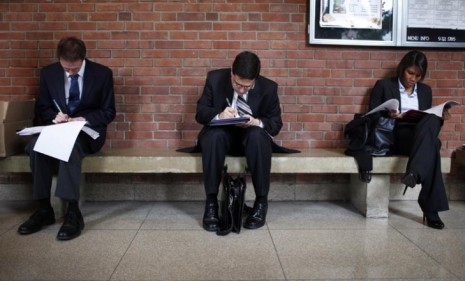The 'surprisingly grim' jobs report: 7 takeaways
The numbers are in for June, and they're ugly. The U.S. economy added just 18,000 jobs last month, and the unemployment rate rose to 9.2 percent

You might want to sit down. And pour yourself a drink. The U.S. Labor Department has released the jobs report for June, and it doesn't look good. Just 18,000 nonfarm jobs were added to the economy last month, compared to 25,000 new jobs in May and 217,000 in April. The unemployment rate rose from 9.1 to 9.2 percent. Here, seven takeaways from the "surprisingly grim" data:
1. The optimists were wrong
"The report throws cold water on the idea, embraced by many economists, that the economy was held back by temporary factors in the first few months of 2011 and is poised for a burst of growth as those factors, such as higher oil prices and the Japanese tsunami-earthquake, dissipate," says Neil Irwin in The Washington Post. That burst of growth hasn't come.
The Week
Escape your echo chamber. Get the facts behind the news, plus analysis from multiple perspectives.

Sign up for The Week's Free Newsletters
From our morning news briefing to a weekly Good News Newsletter, get the best of The Week delivered directly to your inbox.
From our morning news briefing to a weekly Good News Newsletter, get the best of The Week delivered directly to your inbox.
2. Indeed, it's worse than anyone predicted
"Even the most pessimistic economists did not seem to anticipate such a dismal number," says Steve Schaefer at Forbes. Just 18,000 jobs were added; it was expected that that number would be closer 125,000.
3. President Obama is in trouble
"The choppy two-year-old recovery is proving to be one of the worst since the 1930s," say Luca Di Leo and Jeff Bater in The Wall Street Journal. There haven't been enough new jobs added to the economy to make up for all those lost in the financial crisis. "With little scope left for policy to help, President Barack Obama is likely to confront the highest unemployment rate of any postwar incumbent when he seeks re-election in the fall of 2012."
A free daily email with the biggest news stories of the day – and the best features from TheWeek.com
4. The unemployment rate is worse than it looks
While the unemployment rose just 0.1 percent, from 9.1 to 9.2, it's even worse "beyond those headline numbers," says Irwin. Nearly 272,000 people dropped out of the labor force altogether in June — "perhaps giving up looking for work out of frustration." If they'd stayed in the labor force, the unemployment rate would be even higher. If you include those who have given up looking for jobs and those who are underemployed, the broader measure of unemployment increased from 15.8 to 16.2 percent.
5. The public sector is bleeding jobs
With government agencies at all levels struggling to balance their budgets, the public sector lost 39,000 jobs last month. "We can't afford the amount of government service that we've been consuming," says economic researcher Patrick O'Keefe, as quoted by U.S. News & World Report. But we also can't afford too many drastic cuts in government jobs either, says Howard Wial with the Brookings Institute. "Depending upon how big those cuts are, it could slow economic growth down... It could even push us back into another recession."
6. And the private sector isn't making up for it
"Economists were expecting government job losses, but few had predicted that private businesses would pull the reins back so tightly," says Annalyn Censky at CNN. In June, private businesses, which account for close to 70 percent of the workforce, added just 57,000 jobs, making for the most disappointing growth since May 2010, and a big turnaround from earlier this year, when the private sector was adding more that 200,000 jobs each month. "We were building a nice, steady crescendo," says Robert Brusca with Fact and Opinion Economics. "All of a sudden the bottom fell out!"
7. There's little the feds can do
"After spending funds to fight the crisis, policy makers have few tools left to stimulate the economy," say Di Leo and Bater. "Mr. Obama is focused on cutting the budget deficit, while the Federal Reserve, which sees unemployment at about 8.0% at the end of 2012, has already cut interest rates close to zero and is reluctant to purchase more government bonds now that inflation is rising." Perhaps all we can do now is wait and see.
-
 Wake Up Dead Man: ‘arch and witty’ Knives Out sequel
Wake Up Dead Man: ‘arch and witty’ Knives Out sequelThe Week Recommends Daniel Craig returns for the ‘excellent’ third instalment of the murder mystery film series
-
 Zootropolis 2: a ‘perky and amusing’ movie
Zootropolis 2: a ‘perky and amusing’ movieThe Week Recommends The talking animals return in a family-friendly sequel
-
 The twists and turns in the fight against HIV
The twists and turns in the fight against HIVThe Explainer Scientific advances offer hopes of a cure but ‘devastating’ foreign aid cuts leave countries battling Aids without funds